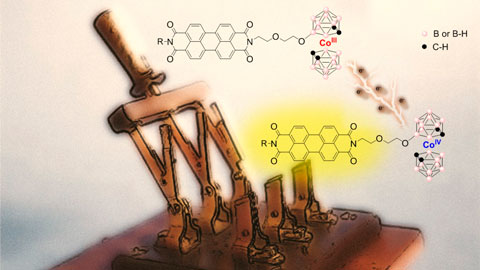A molecular switch is a molecule that can be reversibly shifted between two or more stable states in response to external stimuli, such as a change on pH, light or electric current. These molecules are of interest in the field of nanotechnology for application in molecular computers or responsive drug delivery systems. If in one of the two states (on/off) the molecule is fluorescent, the compounds are then called fluorescent molecular switches, and their applications are even more interesting in the field of life sciences, especially if they can operate in small spaces. For example, they can be used for biosensing and as imaging probes inside cells.
Scientists from the Institute of Materials Science of Barcelona (ICMAB, CSIC) and the Universitat Autònoma de Barcelona (UAB) have developed a set of extremely stable fluorescent molecular switches that can be controlled electrochemically by applying a potential. This is possible due to the presence of a very particular redox active anion—a negatively charged molecule, which oxidizes and reduces very fast. In this case, the anion is the so-called COSAN anion (its full name is cobaltabisdicarbollide, and chemical formula [3,3′-Co(C2B9H11)2]– ), a boron cluster-based complex with a Co(III) center, which has the unusual property to self-assemble into vesicles and micelles.
These systems are the first examples of smart redox-controlled fluorescent molecular switches obtained from boron cluster-based compounds. Due to the presence of the COSAN, they are extremely stable, soluble in a large number of organic solvents, and show a large reversible fluorescence modulation. Additionally, these molecules can form gels with 1D nanostructures by self-assembly, which can preserve in some cases the luminescent behavior.
This research work is the result of a collaboration between Dr. Rosario Núñez from the Inorganic Materials and Catalysis Laboratory (LMI) from ICMAB-CSIC and Dr. Jordi Hernando from the Group of Electrochemistry, Photochemistry and Organic Reactivity (GEFRO) at the Department of Chemistry of the UAB. The experience of the LMI group at the ICMAB in the chemistry, electrochemistry and photoluminescence of boron clusters-based materials, and the experience of the GEFRO group at the UAB in the study of luminescent and electrochemical properties of fluorescent dyes such as perylene derivatives, came together in a very positive synergy that has allowed coupling the particularities of both research areas to produce these new smart molecules with outstanding electro-optical behavior.
“Owing to the presence of the COSAN, the properties of these compounds unambiguously demonstrate their capacity to behave as redox-induced fluorescent switches, which could be of use for the design of molecular memories and information processing devices, biosensing and imaging probes, or electrofluorochromic displays,” says Rosario Núñez, researcher at the ICMAB.
“Moreover, these systems surpass the performance of previous systems based on conjugates of perylendiimides with other metal-based redox units such as ferrocene; on one hand, they display larger reversible fluorescence modulation with minimal degradation, while their solubility in polar media is dramatically enhanced, an essential requirement for future applications in biological systems,” explains Jordi Hernando, researcher at the UAB.
Borate-based passivation layers enables reversible calcium batteries
More information:
Laura Parejo et al. Reversibly Switchable Fluorescent Molecular Systems Based on Metallacarborane–Perylenediimide Conjugates, Chemistry – A European Journal (2020). DOI: 10.1002/chem.202002419
Provided by
Autonomous University of Barcelona
Citation:
Smart fluorescent molecular switches based on boron-based compounds (2020, October 28)
retrieved 28 October 2020
from https://phys.org/news/2020-10-smart-fluorescent-molecular-based-boron-based.html
This document is subject to copyright. Apart from any fair dealing for the purpose of private study or research, no
part may be reproduced without the written permission. The content is provided for information purposes only.



